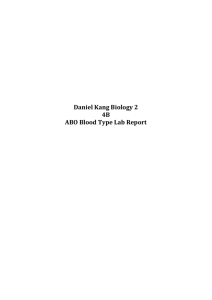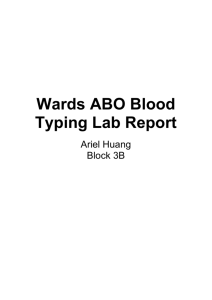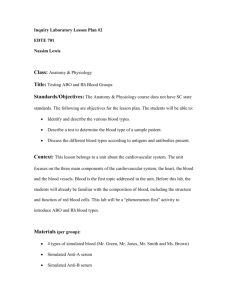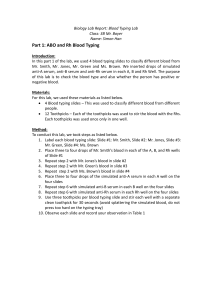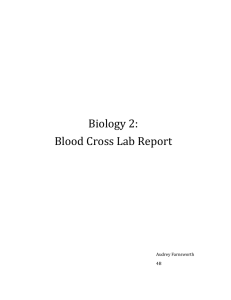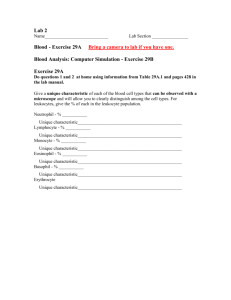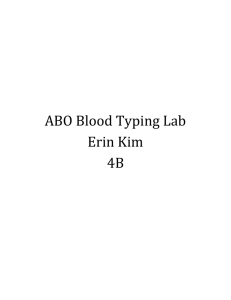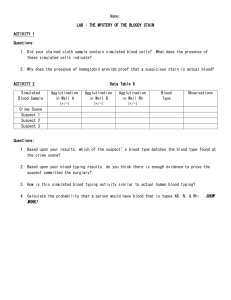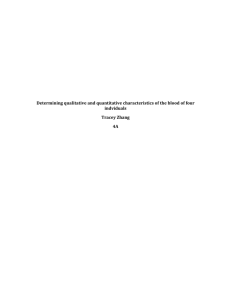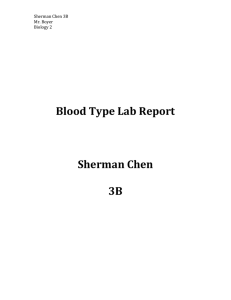Blood Typing Lab Report: ABO & Rh Factor Analysis
advertisement
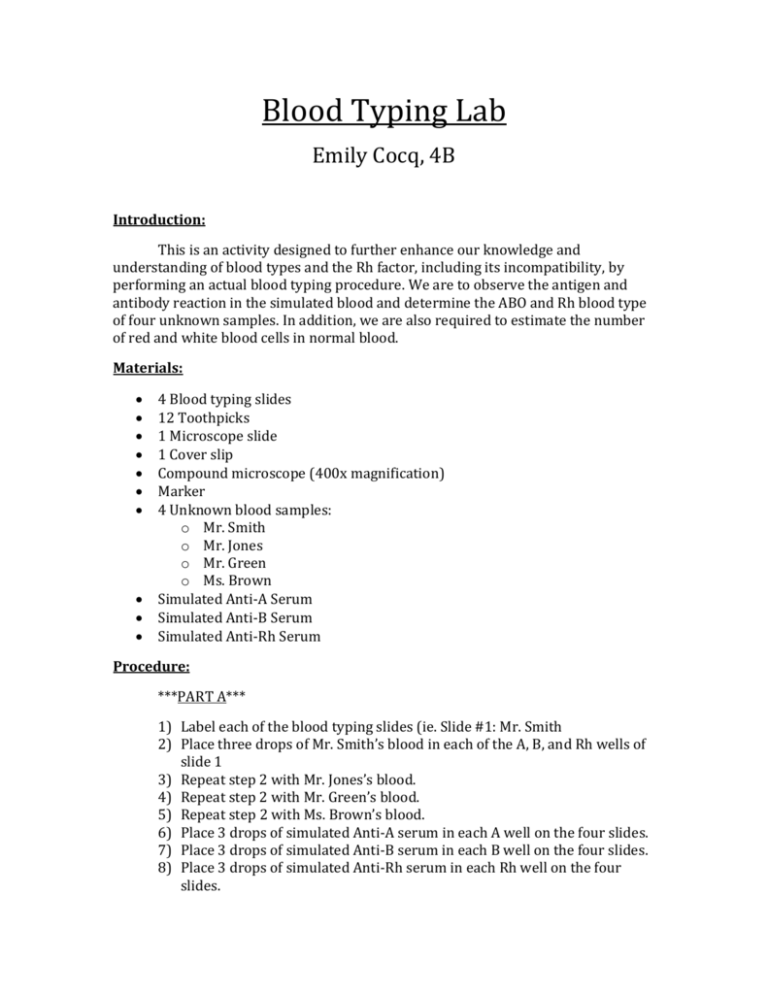
Blood Typing Lab Emily Cocq, 4B Introduction: This is an activity designed to further enhance our knowledge and understanding of blood types and the Rh factor, including its incompatibility, by performing an actual blood typing procedure. We are to observe the antigen and antibody reaction in the simulated blood and determine the ABO and Rh blood type of four unknown samples. In addition, we are also required to estimate the number of red and white blood cells in normal blood. Materials: 4 Blood typing slides 12 Toothpicks 1 Microscope slide 1 Cover slip Compound microscope (400x magnification) Marker 4 Unknown blood samples: o Mr. Smith o Mr. Jones o Mr. Green o Ms. Brown Simulated Anti-A Serum Simulated Anti-B Serum Simulated Anti-Rh Serum Procedure: ***PART A*** 1) Label each of the blood typing slides (ie. Slide #1: Mr. Smith 2) Place three drops of Mr. Smith’s blood in each of the A, B, and Rh wells of slide 1 3) Repeat step 2 with Mr. Jones’s blood. 4) Repeat step 2 with Mr. Green’s blood. 5) Repeat step 2 with Ms. Brown’s blood. 6) Place 3 drops of simulated Anti-A serum in each A well on the four slides. 7) Place 3 drops of simulated Anti-B serum in each B well on the four slides. 8) Place 3 drops of simulated Anti-Rh serum in each Rh well on the four slides. 9) Use 3 toothpicks per blood typing slides and be careful not to get them mixed up, as it will affect the results. Stir well for about 30 seconds, making sure not to spill any blood. 10)Record all observations from the blood reactions. ***Part B*** 1. Thoroughly shake one of the vials of simulated blood. Add one drop of simulated blood to a microscope slide, and cover with a cover slip. Lower the cover slip slowly to avoid trapping air bubbles on the slide 2. Examine the slide with low power (10x). Find an area of the slide with an even distribution of cells. 3. Switch to high power (40x). Refocus and count the number of simulated red blood cells (red spheres) in the field of view. Count the cells in any clump separately. Record the number in table 2 4. Count the number of simulated white blood cells (blue spheres). Record the number in table 2 5. Repeat the counting procedure with two other fields of view. Record these counts in Table 2 6. Calculate the average of the three red blood cell counts and the three white blood cell counts. Record the results in table 2 7. Multiply the average number of red and white blood cells by the dilution factor to determine the number of red and white blood cells per cubic millimeter. Record each value in Table 2 8. Dispose of all materials Data: Table 1 Anti-A Serum Reaction (Type A) No reaction Slide 1Mr. Smith Slide 2Mr. Jones Slide 3Mr. Green Slide 4Ms. Brown Reaction (Type A) No reaction Anti-B Serum No Reaction Reaction (Type B) No reaction No reaction Anti-Rh Serum Reaction (Positive) No reaction Reaction (Positive) No reaction Blood Type Type A (Positive) Type B Negative Type A Positive Type O Negative Table 2 Blood Cell Type Red (Red) White Cell Count 1 240 Cell Count 2 267 Cell Count 3 282 Total # of Cells 789 Avg # of Cells or Total/3 263 11 8 13 32 10.7 Dilution Factor Total # Blood Cells 150, 000 5,000 39,600,000 53,350 Conclusion: There are a total of 39,600,000 red blood cells and a total of 53,350 white blood cells. Evaluation: StrengthsOverall, Part A was very successful. All the data results showed up to be as they were intended and no huge problems were encountered. It was efficient, well paced and was finished in time. WeaknessesIn the first part of the experiment (Part A), our group was very clumsy in spilling a lot of the simulated blood during Step 9. Also, in the second part of the experiment (Part B) my partner and I had not cleaned our cover slip of our slide very well, or there was dust and residue on the microscope lens or light. Whatever the problem, we ended up focusing in on what we thought were red blood cells, but were in fact useless dust. We had to wash and clean everything and get a new cover slip and slide, which took extra time. ImprovementsIf I were to redo this procedure, I would have been more careful in spilling blood in Part A, because droplets could have flown into the other blood wells and interfered with the proper data. Experiments and procedures should be done very carefully in order not to spoil raw data, even if a class period is all that is given. Also, as I have learned from the Part B of the procedure, before starting a lab I will now need to clean every microscope lens where the specimen will be viewed from over or above, and make sure slides and cover slips are also cleaned well, with the proper tissues.
